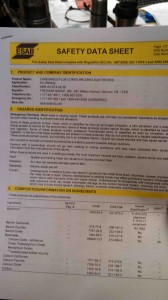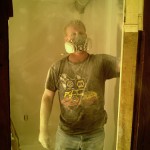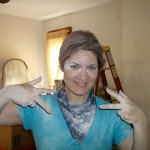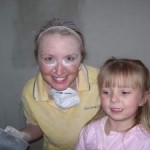Entries tagged with “PPE”.
Did you find what you wanted?
Mon 18 Feb 2013
Reviewing a material safety data sheet (MSDS), or soon to be called a SDS (safety data sheet), can be a useful skill. Most times the product is straightforward and gives you what you need. However, there are somethings to watch for and areas to focus to make your reviewing skills better.
To start, Â make sure you have the right SDS. Match the product with the form. If is is not exactly right, find the right one. It must list the model/product name & manufacturer.
Below are some suggestions:
- What is the date of the SDS?
- is it the most recent?
- when was it last updated?
- Look at section 2/3 (Hazardous components) VERY carefully.
- google the CAS# and find the name (they sometimes hide the true-name)
- look at the % of each component
- what is the listed exposure limit? Is it correct? What about other recommended limits?
- remember the hazard is only listed in this area if it is greater than 1% of the total
- Look through each section mindful of how you will be using the product.
- for example: if you are going to be burning the product, usually the SDS will not address these types of concerns/exposures
- what are the required PPE during “regular use”
- what happens if you use this product in a confined area?
- does the manufacturer recommend air monitoring? when?
- Familiarize yourself with the emergency procedures
- what if it spills?
- disposal?
- what can cause exposure? inhalation? skin?
- Look at the other sections with a inquisitive eye
- do they list other chemicals, which are NOT included in the product section? why?
- do they mention Proposition 65?
- Finally,
- post/make available a copy wherever it’s needed
- make sure you know the product
It is a mixed-bag when it comes to the quality of SDS from a manufacturer. Some of them will work with you, others are a total-pain. Remember it is YOUR RIGHT to know about the products you use. If you don’t feel comfortable with the information they’ve given you, call them. OR, go find another product.
Tue 5 Feb 2013
Posted by admin under Admin Controls, Behavior Based, Chemical Exposure, Engineering Controls, Exposure, Hazard Communication, Management, Personal Protective Equip (PPE), Presentation, Risk, Training
Comments Off on Who is in charge of safety?
Since you are reading this, you probably know the answer. Everyone. But, who is everyone? It should include your CEO/Company President/COO (or similar). If not, I guarantee you aren’t working as safely as possible.
The reason: Â The person doing the work usually isn’t involved in the bidding & planning of the project. Â It’s not always the President’s fault that the proper safety equipment wasn’t bought, or there are no available tie off points on the roof. (But, it might be their fault if they are willing to press forward without making changes.)
Here is one way to deal with these issues. Train the CEO (President/COO/Project Manager/Estimator) beforehand. Here’s how:
- Make the training for them.Â
- Don’t talk about safety harnesses, or the three different types of asbestos.
- Go over big items (where are your claims? what are similar claims for your industry?)
- Emphasize the proper methods to control any hazard:
- #1 engineering controls
- #2 administrative controls
- #3 PPE (in that order!)
- Get them to contact you during the bidding process (not after you’ve won it). Talk about what might be dangerous work & plan for it.
- Share a success story. Ask a superintendent to explain how they controlled a possible exposure.
- Did they make the architect install in a tie-off point?
- Did they ask the owner to change adhesive products to a less hazardous one?
- Did they use an abatement contractor who performed the work well?
- Keep it simple & short. You don’t need a lot of time, but you do need them all on the same page.
When everyone in the company has the same interest in safety, it isn’t hard to explain.
Wed 25 Apr 2012
This blog-post is directed to employees….the drywall framers, hangers, tapers, fireproofers & plasteres who sand and finish mud & drywall.
Question: What type of respirator do you wear when you sand?
…answer? Anything I can find.
This question misleading… and is similar to the one where the attorney asks in divorce court, “Do you beat your wife only when you’re drunk, or all the time?”
But, reiterate.  Do you ever NOT wear a respirator when sanding? Answer: No. We always wear a respirator. It’s dusty.
So if I may ask a leading question (as a bad attorney): What type of respirator would you wear if you were worried about OVERexposure?
Answer: a tight fitting 1/2 face (or full face, for eye protection & fogging control) negative pressure respirator with HEPA cartridges.
I think I’ve made my point. Why would you choose a paper dust mask? The fit is mediocre, they are disposable, you cannot fit test them (very well). Who cares if it’s a N95 or P100. You can feel the dust escaping around your nose. Below are some “average” pictures of people sanding. What will you do?  more info here


Tags: drywall, dust, fit test, framer, hanger, HEPA, IOM, mud, n95, p100, plaster, PPE, respirator, sand, sanding, tape, taper, tight fitting



